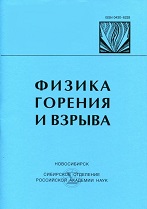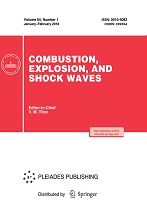|
Excess subsurface heat release as a possible cause of the negative erosion effect in combustion of homogeneous solid propellants
L. K. Gusachenkoa, V. E. Zarkoab, A. B. Kiskina
a Voevodsky Institute of Chemical Kinetics and Combustion, Siberian Branch, Russian Academy of Sciences, 630090, Novosibirsk, Russia
b Tomsk State University, 634050, Tomsk, Russia
Abstract:
An increase in the rate of combustion (gasification) of solid propellants exposed to a sufficiently intense blowing gas flow was discovered experimentally in the 1940s and called erosive burning. Later it was found that for some propellants at relatively low blowing speeds, there may be a decrease in the burning rate, called negative erosion. Attempts to theoretically study negative erosion have been made since 1971 and focused on analyzing changes in the intensity of heat transfer on a burning surface with the leading role of gas-phase reactions, taking into account the effect of large-scale fluctuations in gas velocity and temperature, the effect of the differences in diffusion coefficients and thermal diffusivity of the gas, and the effect of flame stretching. This paper presents an analysis of propellant combustion under blowing conditions in the presence of intense subsurface heat release due to exothermic reactions in the condensed phase. In the case where the surface temperature is limited by the boiling point, local temperature maxima can form in the subsurface layer, leading to an uneven response on the surface and to the occurrence of “intrinsic” turbulence in the adjacent gas layer. This turbulence leads to a change in the heat input to the propellant and allows one to qualitatively explain the effect of negative erosion.
Keywords:
solid fuels, erosion, negative effect, own turbulence.
Received: 21.10.2021
Revised: 11.01.2022
Accepted: 28.02.2022
Citation:
L. K. Gusachenko, V. E. Zarko, A. B. Kiskin, “Excess subsurface heat release as a possible cause of the negative erosion effect in combustion of homogeneous solid propellants”, Fizika Goreniya i Vzryva, 58:6 (2022), 12–32; Combustion, Explosion and Shock Waves, 58:6 (2022), 638–656
Linking options:
https://www.mathnet.ru/eng/fgv885 https://www.mathnet.ru/eng/fgv/v58/i6/p12
|


| Statistics & downloads: |
| Abstract page: | 71 |
|





 Contact us:
Contact us: Terms of Use
Terms of Use
 Registration to the website
Registration to the website Logotypes
Logotypes









 Citation in format
Citation in format 